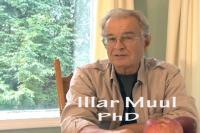Illar Muul, PhD
President, Integrated Conservation Research, Inc.
For thousands of years humans lived close to nature. Everything they needed, nature provided. We still need nature, but somehow now, for many, nature is remote, unknown, or even hostile. In some countries “improved real estate” is the result of removing forest or other natural vegetation. We replace nature with plants and animals we have modified to serve us. We call it agriculture.
But, in many countries people still live close to nature and depend greatly on natural forest products. We call that poverty.
I have spent a lot of time working among aborigine people who live in the forests of Malaysia and Indonesia. Some of them live without any monetary income, or with very little. But, I could not consider them poor. They are rich in knowledge about the plants and animals of the forests, about their uses and about the dangers that some species pose. They are also spiritually rich and have a deep respect for all living things, and each other.
Even in “developed” countries, some people retain love and respect for nature. This may be expressed in small ways, such as keeping pets, or potted plants, gardening, or even hunting (sustainably). As a child, I knew a multimillionaire who purchased thousands of acres of forest near Boston, Massachusetts, and placed it under permanent conservation easements. Many non-profit organizations have done wonderful things in large-scale conservation and preservation.
To me, those people seem to have a “green heart.” I have met them all over the world in the course of our conservation work. However, in most cultures I know, once a rural person “escapes poverty” and enters the “cash economy,” they leave nature behind. They may return to the “village” for weddings or funerals, but they enjoy more the modern conveniences of urban or suburban environments.
However, in two countries I have observed, a larger than usual portion of people have “green hearts.” These countries are Estonia (at 60 degrees north latitude, same as Hudson Bay in Canada) and Costa Rica which is in the wet tropics. In both Estonia and Costa Rica much of the landscape remains forested. Costa Rica is a global model for conservation of tropical rainforests. Much of the agricultural land is becoming reforested as farming is being abandoned, and people are seeking an easier life in the cash economy.
In Estonia vigorous debates are going on regarding the fate of the forests in the context of rapid economic development. However, most Estonians who live in a city or a town have a place in the country where they spend much of their summer. They may own it, or it may be owned by relatives or friends. Although the land may be used for gardening, some is left natural for collecting wild berries, hazelnuts, and mushrooms. Many native plants are used as medicines.
In Costa Rica also many urban people own places in the country. I know some very wealthy business people who have purchased large tracts of farm lands or forest. When they retire from business, they return to a simple life enjoying nature, family, and friends. Some have developed new businesses based on nature tourism, including luxury resorts and natural attractions.
Although their economy is growing briskly, Costa Ricans do not seem to be inclined to cover land with asphalt and concrete. More than 20% of the land is under permanent Government protection. But, perhaps as much, or more, is owned and protected by people with “green hearts.” Many foreigners from Canada, USA, and Europe have also purchased small or large tracts of land that they enjoy as winter retreats or for retirement.
Because of the “green heart” character of both cultures, I believe that Estonians would enjoy property rights in natural Costa Rica. Also, Costa Ricans would enjoy a change of scene visiting Estonia during their rainier months (June - October). I also believe since both cultures share the “green heart” tendencies, the two could be considered “sister countries” for the purposes of tourism, trade, and clean technologies. Why should Estonia buy tropical fruits and fruit products, coffee, etc. through the many “hands” of EU (bananas cost nearly US$1 each)? The two countries could conduct direct trade and save money.
Costa Rica would benefit by buying directly IT items and software produced by Estonia. Also, they could enjoy an European vacation at great savings.
Direct charter flights could reduce travel costs. The travel opportunities would be also be attractive to neighboring Finns, Swedes, Latvians, etc.
The two countries are nearly the same size in land area, and populations are small (Estonia 1.2 million; Costa Rica 4 million). The climates complement each: Estonian high season for tourists is May - September; in Costa Rica December - April. But, the most important link is the “green heart.” Both countries are “green beacons” for the rest of the natural world which is becoming covered or fragmented by concrete and asphalt.
Please contact Illar Muul, PhD, President, Integrated Conservation Research (web site: www.incores.org) for more information on travel, trade, real estate, and “green business” opportunities. Please call: 1 301 371 8988; or email: or .
GREEN HEARTS
Archived Articles | 03 Dec 2007 | EWR
Archived Articles
TRENDING



















